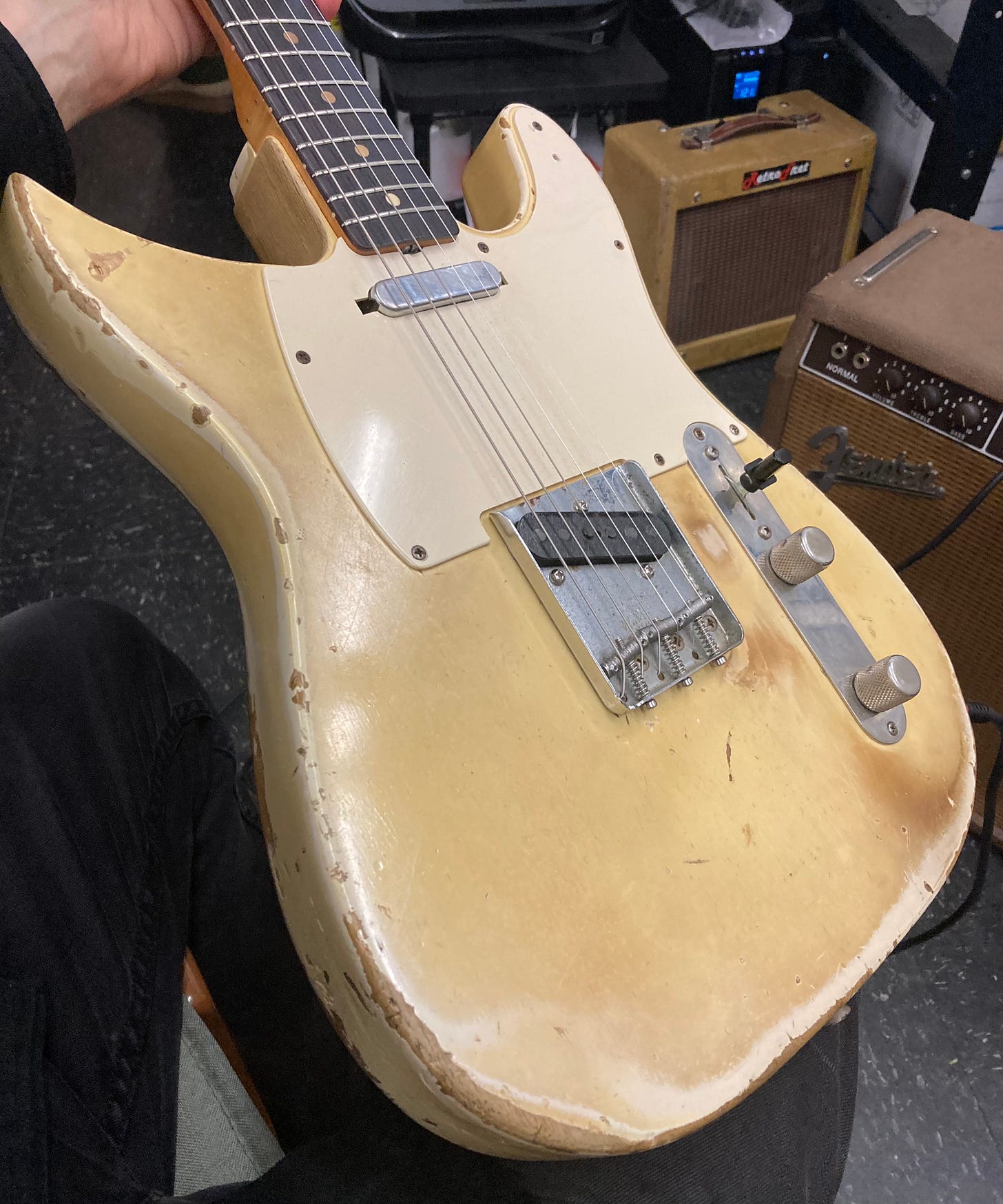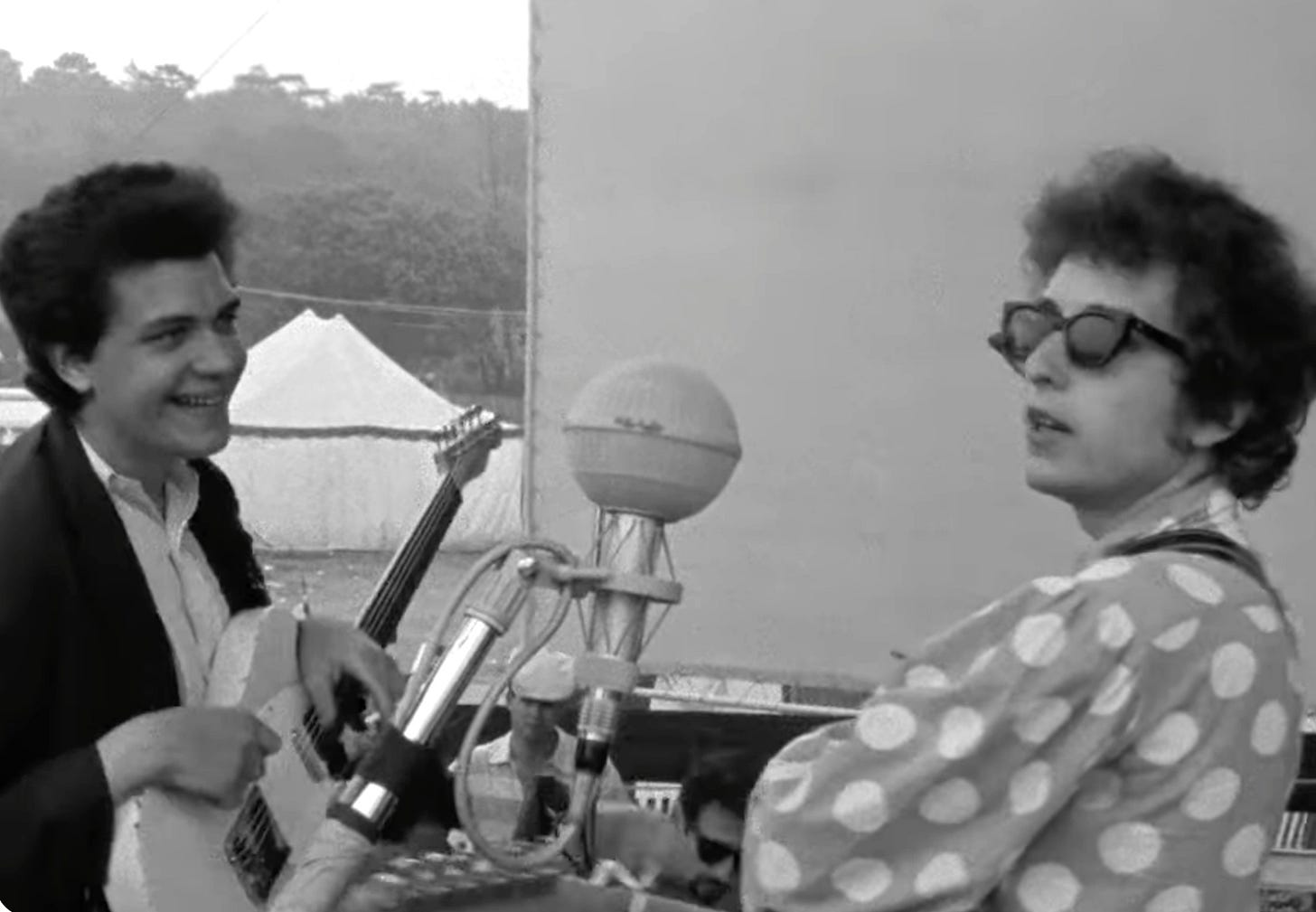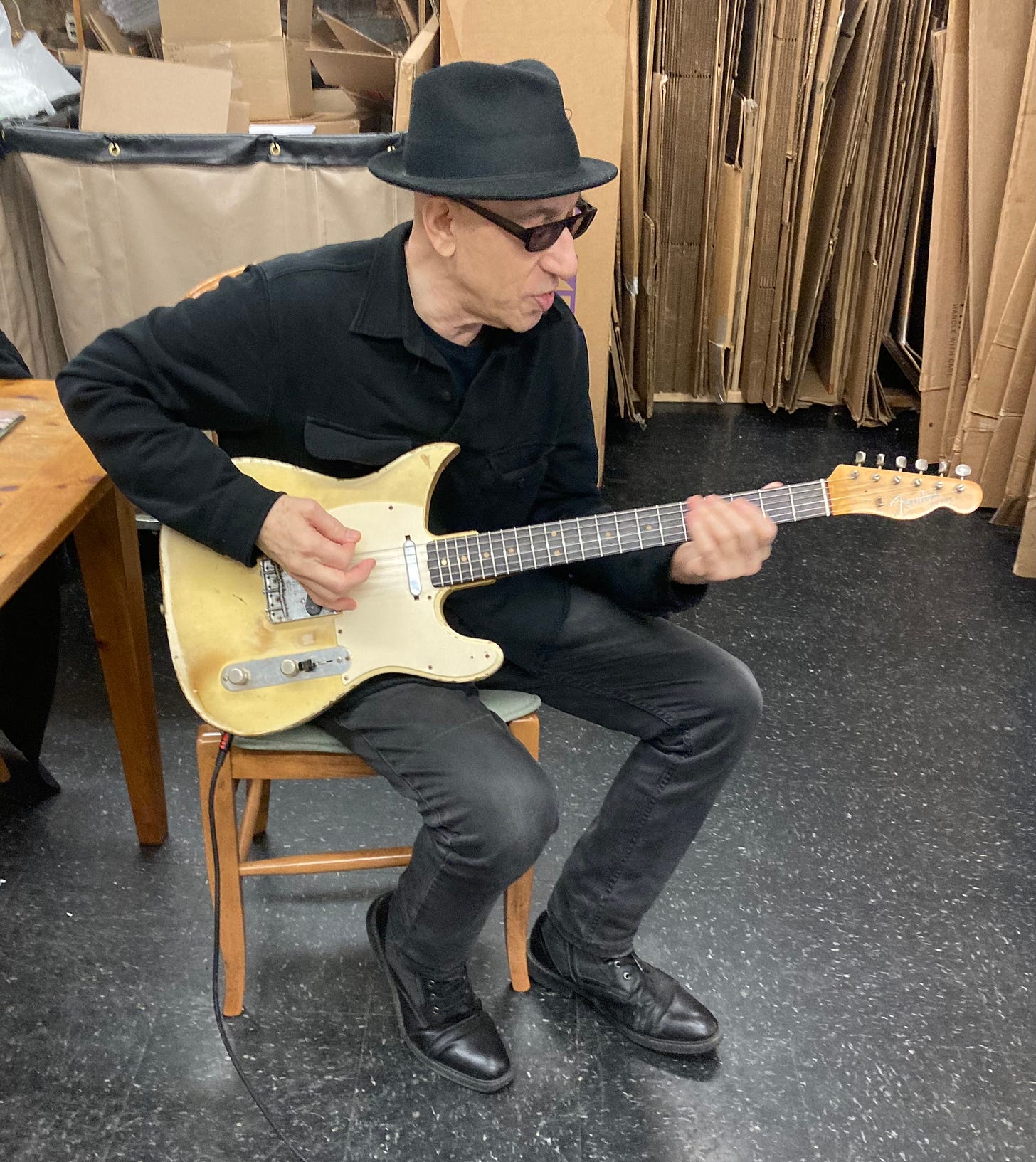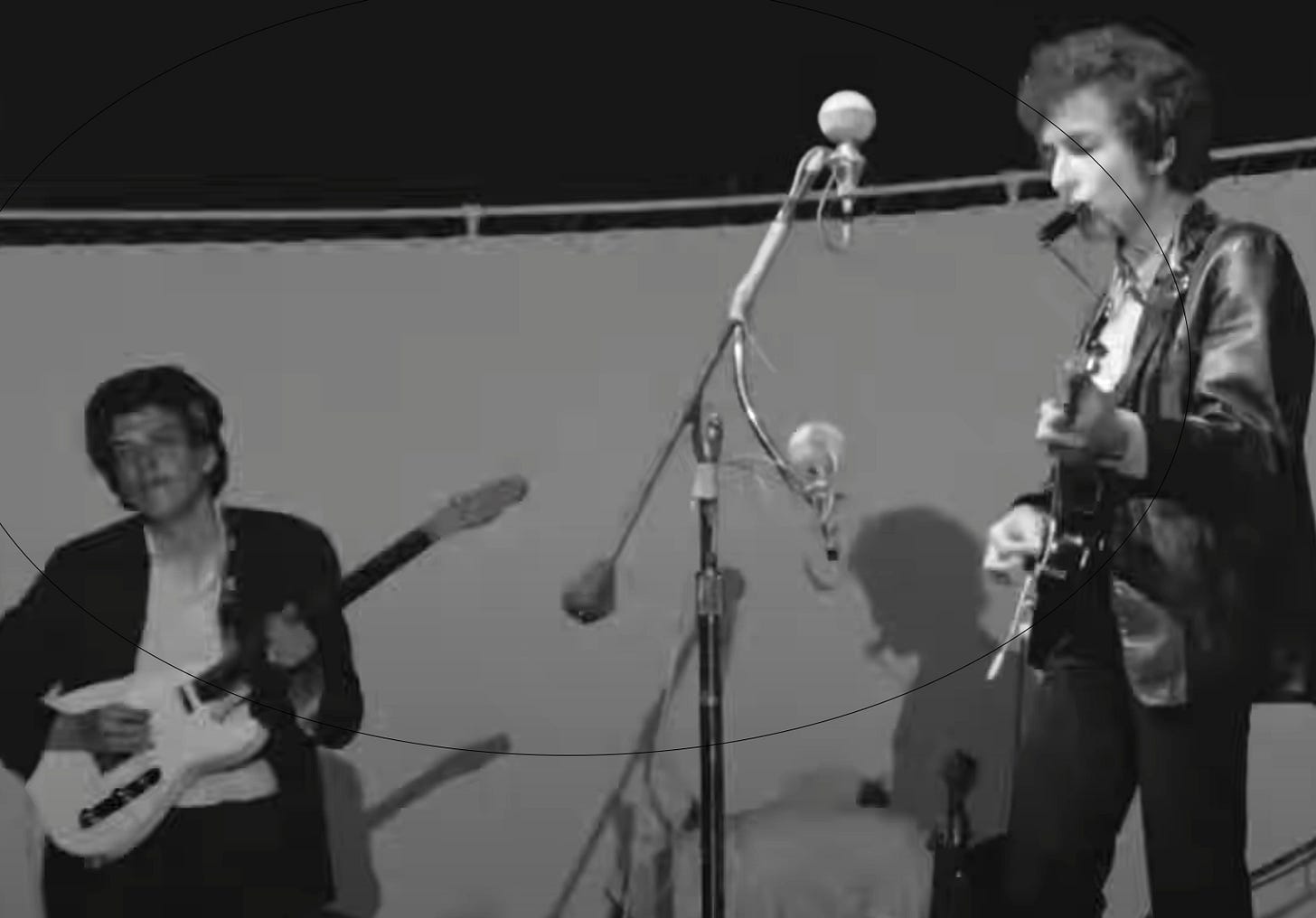Touching The Grail: Playing Mike Bloomfield's Telecaster
Encountering "the guitar that killed folk music."
A posting from Chris Such set it off: here it was in all its glory, the legendary 1963 Fender Telecaster owned by Mike Bloomfield in 1965. It was played by him on the first album by the Paul Butterfield Blues Band, on Bob Dylan's recording session for the Highway 61 Revisited album which included the hit single Like A Rolling Stone, and in Dylan's earthshaking performance at the 1965 Newport Folk Festival in which he was accused of betraying the folk scene and "going electric", a mission aided and abetted by Bloomfield's LOUD guitar. The Newport brouhaha earned this particular Telecaster the sobriquet "the guitar that killed folk music." Could it be right here in the East Village? I immediately fired off a message to Chris who informed me that the guitar was at Retrofret Guitars, my friends in Brooklyn. Peter Kohman said to come on by so plans were made.
Bloomfield and Jeff Beck were my first guitar heroes even before I ever dreamed of playing the instrument myself. My initial rock n roll experience was in 7th Grade in 1964 playing in The Last Words in which I wielded a Bb clarinet with a crystal microphone taped in the bell to emulate a fuzzed out guitar. We came in second in the school battle of the bands but broke up soon after. My favorite songs allowed me to imitate Jeff Beck's Dionysian guitar tone on songs like For Your Love by The Yardbirds and Satisfaction by the Rolling Stones' Keith Richards. Listening obsessively to The Yardbirds and perhaps as importantly, reading the liner notes, introduced me to names like McKinley Morganfeld aka Muddy Waters, Chester Burnett aka Howlin' Wolf, Bo Diddley, and John Lee Hooker.
Dropped at the end of July 1965, we'd already had over a month to absorb Like A Rolling Stone with its torrent of furious lyrics and keening guitar before Dylan's album Highway 61 Revisited was released at the end of August. Mike Bloomfield's name and sound became known to me and then, a month later, the whammy punch of the first Butterfield album driving home what an inventive and powerful guitarist he was. The back cover of both Highway 61 Revisited and the Butterfield both showed Bloomfield playing a utilitarian-looking blond Fender Telecaster and its piercing sound became one of my Platonic ideals for perfect guitar tones. Jimi Hendrix entered the picture with the release of Are You Experienced on May 12, 1967, and my ideas of guitar sound and technique expanded deeply and widely with Hendrix soon leading the pantheon of guitar heroes (but that's another story).
I acquired my first electric guitar rig, a used Hagstrom III accompanied by a small Fender amplifier, in the late spring of 1968 as I was completing my junior year of high school. At the end of that June I headed to Pittsburgh and Carnegie-Mellon University with guitar in hand where I became a scientist's assistant as part of the Ford Future Scientists of America fellowship program. I enjoyed the work in the lab where I was creating switching systems for a project called Spelltalk, a Mellotron-like device for the blind that would read books out loud by triggering phoneme loops after the text was converted to teletype tape. My free time in the lab was spent designing and building better fuzz boxes and playing with a multi-head tape deck that was used for time studies. I soon found that the scientists there spent most of their time thinking about how they could get money for their pet projects from the Defense Department. This being the time of the Vietnam War, I did not share their dreams or desire such an association plus I was already involved in anti-war activities in my high school. I gravitated towards the radio station, WRCT, and secured a midnight-to-4am slot. 1968 was an excellent year for sonic weirdness and I filled my playlist with a blend of psychedelia, blues, contemporary chamber and orchestral works, and non-Western music as much for my own curiosity and edification as to please my listeners. I would almost always find a slot for a track that featured Bloomfield. It might be his hot new Super Session album, his "American music" band The Electric Flag, the Butterfield album East-West, the Flag's soundtrack to Peter Fonda's film The Trip, or perennial favorite, Bob Dylan. I always pictured Bloomfield with that Telecaster even though I knew he had switched to fatter sounding Gibson Les Pauls. When I returned to my parents' house from Pittsburgh, long-haired and bearded, I decided to switch to acoustic guitar and traded my rig for a low-level Gibson archtop to pursue my new passion for country blues, old-timey music, and abstract Americana, all honed during my senior high school year. Now at at Cornell University, in 1970 the electric virus struck me again though this time in the form of an unwieldy and fragile ancient Fender pedal-steel guitar. Frustrated at its propensity for breaking strings, I found a used blond 1968 Telecaster for cheap and set about learning to play which entailed deep listening to all of my heroes and trying to find those places on the fretboard where their sounds intersected with my fingers. With my Tele plugged into a cranked Fender Twin Reverb and with BB King and Albert King as jumping off points, the vocabularies of Bloomfield, Hendrix, and Beck, even John McLaughlin, began to come into focus
.There's ample documentation both about Bloomfield's tragic life trajectory thanks to drug addiction and the status of his various guitars. The story of this particular 1963 Telecaster may be found at the Vintage Guitar Magazine site: https://www.vintageguitar.com/25061/michael-bloomfields-63-telecaster/
When I visited Retrofret on Saturday, January 11, 2025 to check out the legendary axe, Peter and George filled me in on some relevant details including the price explosion of this particular instrument. The vintage guitar market may be seen as obscenely inflated with instruments associated with a particular luminary fetching many times their 'real' value as musical tools thanks to the influence of the "collectors": wealthy boomers, hedge fund billionaires, corporate CEOs, lawyers, current rock superstars, and other celebrities: all wishing to acquire for themselves some of the aura of the original owners of these guitars.
We descended into the basement of Retrofret, away from the crowded showroom. A chair had been set down for me with an aged Fender Pro amp placed nearby. Rather than cynicsm taking hold, when Peter brought over the Telecaster and handed it to me, I could feel my heart pounding a little faster. This was an historic instrument, a tool that had now become an artifact, a touchstone that helped change the direction of culture in the world and one whose sound I had listened to countless times, its sonic DNA intertwined with my own.
When the guitar was gently transferred to my hands, my first sensation was one of surprise as to how light it was. Teles varied greatly in weight depending on not just the type of wood used for the body (which may be pine, ash, or swamp ash) but especially on the particular piece. This ash body had no seams, just one single slice, a factor thought to enhance the tone. Glaring at me was the big chunk cut out of the upper horn by the late John Nuese, a Boston guitarist who received the guitar in trade from Bloomfield in late 1965 in exchange for a 1954 "goldtop" Les Paul which Bloomfield played on the visionary second Butterfield album East West. Nuese was left-handed and wanted to turn the guitar over to be able to reach the upper frets and so performed this somewhat crude surgery. Some would call it butchery. Ironically, there are guitar collectors who will pay extra money to have their new guitar "reliced", to make it seem as if it had spent the last half-century being throttled in rustic honky-tonks steeping in tobacco smoke and rotgut alcohol only to be displayed in glass-and-polished-wood cases.
I placed my hand on the neck to feel the contour. Another surprise, this neck was extremely narrow in width and slim in depth. Some old Teles have quite chunky neck profiles, variously described as telephone poles or baseball bats. The action on this one was low and I was told that the guitar had twice been refretted to give it a feel that was silky and slinky - ideal for many players but actually too light for my taste as I prefer a guitar with slightly higher action and string tension so as to provide a bit of resistance when played. Still, at a price of $275,000.00, I certainly wasn't going to think about purchasing it so could just appreciate it for what it is. And that I did
Plugging it in, I turned the amp up just enough to give it a little authority but not really loud enough to be truly electric. The sound of an electric guitar is the sum (or perhaps greater than the sum!) of the parts: guitar construction, pickups, type and gauge of strings, type of amplifier, gain and volume, and most importantly, the touch of the player. I wanted to feel this guitar as a physical instrument, not so much as part of an amplified system. And as far as that went, it felt really good (perhaps not a surprise given its provenance). It was tempting to run the ascending chord progression from Like A Rolling Stone that reaches its climax in a triumphant G chord with Bloomfield's signature filigreed lick at the end...I did succumb. Or some finger-picked Robert Johnson riffs or Bloomfieldish hyperactive blues lines inspired by a range of players including Otis Rush, Albert King, Clarence "Gatemouth" Brown, Hubert Sumlin, and even Howard Roberts. Yes! And some BB King licks as supercharged by Bloomfield in The Electric Flag and Super Session recordings (played on both a Les Paul Standard and Gibson ES345) but translating quite easily to the Telecaster. Of course! Finally, I played some of "my own" contrapuntal and textural playing and felt the meld that happens when you stop thinking about what you're playing and just play it. The tone was centered and vivid in all switch positions, articulate and brash but still warm. This is a guitar that if you knew nothing about, you'd have to love it just for it being as it is.
One must question how much the instrument itself is transformed by those who have played it. Certainly, this is believed to be the case by many musicians and I admit, some instruments seem to have some extra vibe to them when you pick them up, correlated by their history or tales that had grown around them. I feel a chemical bond with my various instruments that is activated when they are taken into my hands and put into action. When touring, there are times when I've walked into a performance space for setup and soundcheck and sensed the ephemeral imprint of the music played on the previous night as if the molecular structure of the walls and ceilings of the edifice had been somehow physically altered by the vibrations. Can this be verified or is it my own projection based on myth, hearsay, publicity, fantasy? Possibly this "imprinting" will become real and measureable in the near future thanks to some technology that currently we do not have access to, say, when quantum computing is the norm or some allegedly-occult parasciences have been proven to be very real
.The question remains: is any of Michael Bloomfield's sonic DNA or finger-mojo preserved in this instrument? I prefer to think of this particularly iconic instrument as an intersection between Bloomfield's personal expression and playing style as encoded into amn abstract sonic enzyme that interacts with a substrate, the physical vector in the form of a Telecaster guitar. These elements are irrevocably separated in time and space and yet eternally linked in the greater cosmic flux. I was thrilled to touch, if ever so slightly, that flux, and become part of it
.









